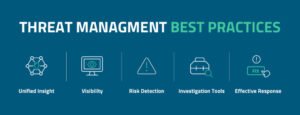
Organisations face an ever-growing array of cyber threat management nowadays. They range from simple phishing attacks to sophisticated, multi-faceted intrusions designed to steal sensitive data or disrupt operations. As such, businesses must adopt comprehensive strategies to protect their assets and maintain the integrity of their operations.
The need for effective threat management has never been more critical. Companies must stay ahead of cybercriminals by implementing robust security measures and proactive strategies. Organisations can significantly reduce their risk of falling victim to cyber-attack by focusing on key components of advance threat management.
Risk Assessment and Prioritisation
An essential step in managing potential threats is conducting a thorough risk assessment. This process involves identifying and evaluating potential risks to the organisation’s systems and data. By understanding the vulnerabilities within their infrastructure, businesses can prioritise which areas require immediate attention and allocate resources accordingly.
Risk assessment should be an ongoing process as the landscape constantly evolves. Regular reviews and updates ensure the organisation remains vigilant and prepared to address new challenges. Prioritising risks based on their potential impact allows companies to focus on the most critical areas, ensuring a more efficient and effective security posture.
Implementing Multi-Layered Defense
A multi-layered defense strategy is crucial for protecting against various threats. This approach involves deploying multiple security measures at different levels of the organisation’s infrastructure, creating a comprehensive barrier against attacks. Layers may include firewalls, intrusion detection systems, anti-malware solutions, and secure network configurations.
By combining various protective measures, companies can enhance their ability to detect and respond to attacks. Each layer serves as a checkpoint, making it more difficult for unauthorised individuals to access sensitive information. Additionally, this strategy ensures that even if one layer is compromised, others remain in place to prevent further intrusion.
Continuous Monitoring and Incident Response
Continuous monitoring is a critical component of effective threat management. Organisations can quickly identify and respond to suspicious behavior by constantly observing network activity. Advanced monitoring tools provide real-time insights, enabling swift action to mitigate risks.
An efficient incident response plan is also essential. This plan outlines the steps to take during a security breach, ensuring all team members know their roles and responsibilities. Prompt response to incidents can minimise damage and reduce recovery time, helping the organisation return to normal operations as quickly as possible.
Employee Training and Awareness
Human error is a significant factor in many security breaches. Therefore, educating employees about best practices and potential threats is vital for maintaining a secure environment. Regular training sessions can help staff recognise phishing attempts, understand the importance of strong passwords, and follow protocols for handling sensitive information.
Creating a culture of security awareness encourages employees to take an active role in protecting the organisation’s assets. By fostering a sense of responsibility and vigilance, companies can significantly reduce the likelihood of successful attacks stemming from human error.
Leveraging Threat Intelligence
Threat intelligence involves collecting and analysing data on current and emerging threats from various sources. This information helps organisations stay informed about the latest tactics used by cybercriminals and adjust their defenses accordingly.
By integrating this into their security strategies, companies can proactively address potential risks before they materialise. This approach enables more informed decision-making and ensures that security measures remain relevant and effective in the face of evolving threats.
Advance threat management requires a multifaceted approach that combines risk assessment, multi-layered defense, continuous monitoring, employee training, and leveraging threat intelligence. By implementing these key strategies, organisations can enhance their security posture and protect their assets. Staying proactive and informed is essential for maintaining the integrity and continuity of business operations in today’s digital landscape.